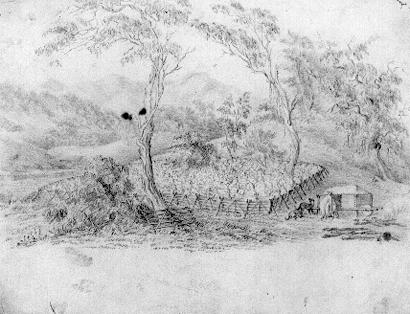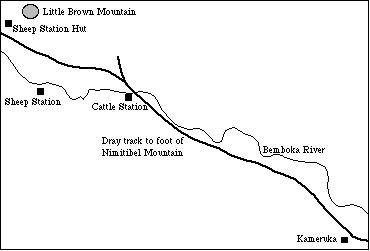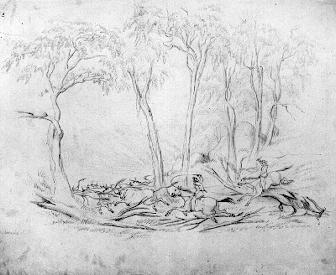
Early Settlement of the Bemboka District
The south-eastern corner of New South Wales was inhabited long before the arrival of European settlers. Its original inhabitants were a group of Aboriginal tribes known as the Yuin. From Bega to Twofold Bay the land was inhabited by the Thaua tribe who led a traditional Aboriginal lifestyle which had developed over tens of thousands of years. As with other Aboriginal tribes the Thaua tribe did not have a system of land ownership like that used by European societies. They followed instead a tradition of wandering within established tribal boundaries in a semi-nomadic manner and seeking permission before crossing another tribeís boundaries. Failure to seek this permission often resulted in inter-tribal warfare with the brutal loss of many lives.
The Thaua tribe comprised many smaller sub-groups each inhabiting a
particular locality. One of these small tribal groups was located in
the Benbooka region of what was known in the days of early European
settlement as the Twofold Bay District. In 1841 George Imlay, acting
on behalf of the government, prepared a return of natives in the Twofold
Bay District and in this list he included the following information on
Aborigines in the Benbooka area.
| English Name | Native Name | Age | Wives | Children | |
| Male | Female | ||||
| Benbuka Major | Tulanero | 48 | 1 | 1 | |
| Chudero | 60 | 1 | 1 | ||
| Charlie | Gerra | 14 | |||
| Benbuka Tommy | Nalija | 38 | 1 | ||
| Jamie | Pukembul | 17 | 1 | 1 | |
| Rowdy | Genar | 60 | |||
George Imlay concluded the census details of his return to the government with a report explaining the reasons for the small tribal numbers, especially the low number of women in the tribes.
The disproportion between the adult sexes may be accounted for by the introduction of the measles amongst them, about five or six years ago, by which disease the female part of the community suffered in a much higher degree than the male.
The Thaua tribe were hunters and food gatherers who lived in harmony with the environment as they took only that which was required for their survival. In 1844 George Augustus Robinson, the Chief Protector of Aborigines, travelled through the Twofold Bay District as part of a journey to the tribes of the coast and eastern interior. He reported that wombats and fish formed the main part of the natives' diet with the fish being caught in weirs in the rivers and creeks. Eels and other fish in ponds were stupified by the infusion of bark. The most common fruits eaten by the natives were the Kangaroo Apple and the Native Cranberry.

Aboriginal tribe in camp
Aboriginal shelter was usually quite temporary in its construction because the Aborigines moved camp regularly in search of fresh food and water and when the seasons changed. The shelter was made from readily available materials such as bark, branches, reeds and grass. Robinson described two types of local Aboriginal shelter.
Their huts... are simple and rude being a mere sheet of Bark in a triagonal shape with barely sufficient room to sit under.
Some of the Huts in the locality resembled a beehive and others the half of a cupola.
The physical differences between tribal groups and the style of their ceremonial appearance was noted by Robinson as he travelled through the district.
I proceeded Northward and conferred with a large party ... they are tall (some upwards of six feet) and well made and in this respect superior to the piscatory people of the coast ... I was forcibly struck with the Mode in which some of the male Aborigines dressed. Their hair bedaubed in the pigment of Ochre and grease, it was spun out into innumerable small ringlets hanging round their heads like the thrums of a Mop, and covering half the face.
When Robinson passed through the Benbooka area on this journey he made no mention of European settlers. This is depite the fact that Europeans had been living in most other parts of the district for more than a decade. He did, however, make reference to the landform known today as Brown Mountain.
I succeeded on the 14th [September] in getting the horses to the top of the dividing Range at the Nimmittybel said to be the highest land on Maneroo. In Colonial phraseology a difficult ascent is significantly termed a Pinch but the Nimittybel on account of its very abrupt and precipitous character is aptly named a Steep. Stockmen and others prefer the more circuitous Route (by Hibberts) of twenty or thirty Miles rather than ascend or more properly speaking climb this difficult Mountain.
It was the difficulty in crossing this spur of the Great Dividing Range that delayed the European settlement of Benbooka. When travelling between the Coast and the Monaro the popular routes were via Big Jack Mountain and Tantawanglo. It was to be many years before a suitable access was to be found on the Brown Mountain. Prior to vehicular access on the Brown Mountain being established the Benbooka area was an extremely isolated part of the Twofold Bay District.
The 'limits of location' of settlement had been established since 1829 when Governor Darling proclaimed the nineteen counties to the immediate north, west and south of Sydney. Beyond these counties were the 'waste lands' and it was illegal to occupy these lands. Despite Governor Darlingís proclamation pastoralists did enter these lands with their stock and squatted illegally. It was the Imlay Brothers, Pater, George and Alexander, who came to the Twofold Bay District in the early 1830s and began grazing sheep and cattle on Crown Land beyond the limits of location as well as operating a whaling station at Twofold Bay.
This illegal operation continued until 1836 when Governor Bourke introduced an Act that allowed squatters to pay a 10 licence fee to hold their land as an annual tenant of the Crown. There was no limit to the size of the squatting run as the 10 licence fee was paid by large and small squatters alike. In 1844 Governor Gipps introduced restrictions to the size of the squatting run that could be covered by a single licence. The maximum size was now twenty square miles carrying 4 000 sheep or 500 cattle.
The first recorded presence of European settlement in the Benbooka area was the establishment of a cattle station by the Imlay Brothers in the area now known as 'Old Bemboka'. It isn't until much later, however, that anything is known of the people who settled the area. It was in May 1852 that John Marks arrived at Polacks Flat with his wife Lucy Ann and an infant daughter Elizabeth. By this time the Walker family had taken over the holdings previously controlled by the Imlay Brothers and John was employed as a shepherd and with another young man was watching over two flocks.
Lucy Ann Marks provided details of the extent of the Walker's holdings in a letter to her parents.

Sheep penned for the night
... the master that they are shepperding for as got between thirty and forty thousand sheep. Walker is the Master Name. Mr Balden is only Over seear for them.
John and the young man were paid 54 pounds per year and given rations of flour, meat, sugar and tea. If they lost any sheep they had to pay 5 shillings a head for them. The two men worked long hours as they started work at sunrise and didn't get home until sunset each day. Lucy Ann and Elizabeth were left at home all day by themselves.
When Lucy Ann wrote to her parents she also described some of the trip from Twofold Bay to Polacks Flat and how isolated their new place of residence was..
We went to the next station on Monday tuesday to the next and Wednesday to the next ... mind Father these stations are 6 and 12 Miles Apart no other hut or other Persons between them ...we went 12 miles further ... and orrad Roads ...Roads they are not for it is all Bush all hills and mountings ... we are now living at A Place called Polacks flat ... I cannot send you much News my self for I am were I can see nothing nor no body only Trees Hills and Mountings. A Man comes with Rations A bout once A fortnight and the Master comes A bout once A month or six weeks.
The perils and deprivation experienced by the few local inhabitants was clearly shown when Lucy Ann wrote of the problems of childbirth in the bush. This was even after arranging for a girl from the next station to stay so she would not be alone.
Dear Father I am happy to tell you i am got Safe over My Trouble once Again. I was Confind with A nother little Deaughter on the 5 of August A bout 5 Oclock in the Morning ... But Dear Mother I could not help laughing when it was comming on the girl was frightoned and ran Away and sent in the Man and so I had A man Midwife ... thank God it was soon over. But their is no Church or Chapple up in the Bush to get them Chrissened.
During the 1850s the population gradually increased throughout most parts of the district but not at Benbooka. By the time the 1859 Electoral Roll for the Eden District was prepared there were 33 male residents at Kameruka and 16 at Wolumla but at Benbooka there were only 2 male residents. These men were John Davis and James Porter and they were employees of the Twofold Bay Pastoral Association, a group of businessmen who taken over from the Walker family. Davis was a shepherd and Porter was a stockman and they were responsible for supervising the sheep and cattle runs in the Benbooka district. These runs were a part of the Association's Kameruka lease which was estimated to be 192 640 acres.

Location of cattle and sheep stations in the late 1850s

Cattle muster

Cattle being yarded
By the late 1850s there were about 10 000 cattle in the Benbooka run and they comprised every imaginable size, age, shape and colour. They were supposed to carry the old bible brand but many of them were clean skins. The cattle were not handled often so they were very wild and hard to muster. To overcome the difficulties involved in mustering such a large herd of wild cattle additional steps had to be taken, as George E. Ward, overseer of the Benbooka run, explained:
The cattle had never been mustered and were very wild and trap yards were built at intervals of five miles right around the area. A tailing-mob of some 200 quiet beasts were then driven out to act as a decoy then all animals were mingled by outriders and the whole company forced into the nearest trap yard. All impossible beasts were shot by skilled marksmen at the command of the overseer.
The mustering would last up to a week when the tailing mobs with about an equal number of captured animals were driven into the Benbooka branding yards. These musters were very labour intensive and over twenty stockmen, both Aboriginal and European, were required to successfully complete the task. Celebrated horsemen of this time were Tommy Power on 'Snake', Harry Stewart on 'Rainbow' and the black stockmen Briney and Bodalla. According to George E. Ward:

Brumby chase
Briney rode a big brown horse named 'Ironsides', a notorious bolter. He substituted the ordinary bridle-bit with an iron bar nine inches long with a hole in either end to receive the reins.
Besides the 10 000 cattle there were wild horses which were considered a nuisance. These horses were brumbies which originated from the Imlay's horse stations at Tantawanglo and Buckajo. They roamed the district and over time bred up to an estimated 6 000 in number. All these horses were eventually shot and three of the expert riflemen involved in this operation were William and Sam Hanscombe and Fred Jaggers. Usually a mare or foal was brought down and the whole mob would stand its ground until the very last animal was shot.
As the 1850s drew to a close the end of an era was in sight. The population in rural areas was increasing and many people were pressing the government to make available more land for purchase. Of particular concern was the vast area of land held under leasehold by organisations such as the Twofold Bay Pastoral Association. A petition signed by forty three local people was sent to the Duke of Newcastle, Minister for Foreign Affairs of the Home Government. It suggested that portions of land of up to 100 acres be made available at £1 an acre. In time the colonial government acted upon these concerns and introduced legislation that lead to the large holdings being broken up.
Acknowledgements
Information: Bemboka - Village in a Valley
Images: Mitchell Library
Thank you Wayne and The Bemboka Public School